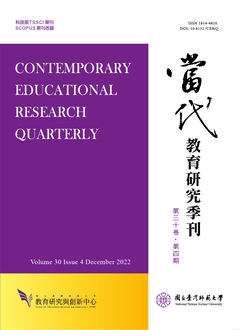

研究目的
本研究主要目的在於,透過觀察來檢視學習區中,幼兒可能抱 持的幼兒成就目標向度,並進一步分析幼兒成就目標的特定性與普 遍性。
研究設計/方法/取徑
本研究以南部地區幼兒園 8 個班級的 4—6 歲幼兒為對象,採用 幼兒六向度成就目標檢核表,分別在各班的積木區與益智區觀察了367 與 348 人次。扣掉無效觀察結果後,以積木區的 271 筆和益智區 的 286 筆有效觀察資料,進行質化描述與卡方適合度檢定。
研究發現或結論
研究結果顯示,在積木區與益智區皆觀察到幼兒表現出與六向 度成就目標有關的語言和行為表現。進一步進行卡方檢定的結果顯 示,在積木區與益智區中,幼兒六向度成就目標的比例有所不同, 其中,在積木區,趨向任務目標、趨向自我目標與趨向他人目標的 比例較高。相反的,在益智區,逃避任務目標、逃避自我目標與逃避他人目標的比例較高。結果可能意謂著,整體而言,幼兒六向度成就目標具有普遍性,但部份成就目標向度則有其特定性。
研究原創性/價值
國、內外相關研究皆缺乏對幼兒成就目標的討論。極為有限的 國外研究顯示,幼兒可能僅抱持四向度成就目標,但幼兒成就目標 的特定性或普遍性仍不清楚。本研究透過深度觀察發現,不論是在 積木區或益智區,皆可從幼兒的語言和行為表現中,發現幼兒抱持 六向度成就目標的證據。關於幼兒成就目標普遍性與特定性的發現, 為國內、外相關研究首見,可作為未來研究者覆驗或設計幼兒成就 目標量表的參考,甚至可作為未來進行幼兒成就目標長期追蹤研究 分析的基礎。
Purpose
The main purpose of this study was to understand possible dimensionalities of achievement goals that preschoolers perceived through observation. Further, the specificity and generality of achievement goals were examined through statistical analysis.
Design/methodology/approach
Young children aged between 4 and 6 years were recruited from the same class in eight public and private kindergartens in Southern Taiwan. In total, 367 and 348 observations in the brick and intellect areas, respectively, were obtained for preschoolers by using six- dimensional achievement goal checklist. After removing invalid observations, 271 and 286 observations were qualitatively described and analyzed using chi-square appropriateness analysis.
Findings/results
The results revealed that the observed conversations and behaviors were related to six-dimensional achievement goals in both areas. Furthermore, the proportions of approach-task goals, approach-self goals, and approach-others goals were higher in the brick area than in the intellect area. By contrast, the proportions of avoid-task goals, avoid-self goals, and avoid-others goals were higher in the intellect area. In general, preschoolers’ six-dimensional achievement goalsfeatured generality as well as specificity to a certain extent.
Originality/value
Few studies have discussed preschoolers’ achievement goals. Limited research has demonstrated that preschoolers may posit four- dimensional achievement goals, but the specificity and generality of these achievement goals remain unclear. The present study found evidence supporting six-dimensional achievement goals among preschoolers through in-depth observation of their language and behaviors in both brick and intellect areas. The specificity and generality of preschoolers’ achievement goal have not been proposed in other studies. The results of the present study may serve as a reference for examining and designing a scale for preschoolers’ achievement goals. Moreover, the results may form the basis of future longitudinal studies.

本著作係採用創用 CC 姓名標示-非商業性 3.0 台灣 授權條款授權.
本刊國立台灣師範大學教育研究與創新中心
106台北市和平東路一段162號 | 電話: 02-7749-3670 | E-mail: cerecerq@gmail.com
教創中心 | 師大 | 電子報 | 線上投審系統
本刊由國家科學及技術委員會人文社會科學研究中心補助經費
© 2014 CERI-NTNU
